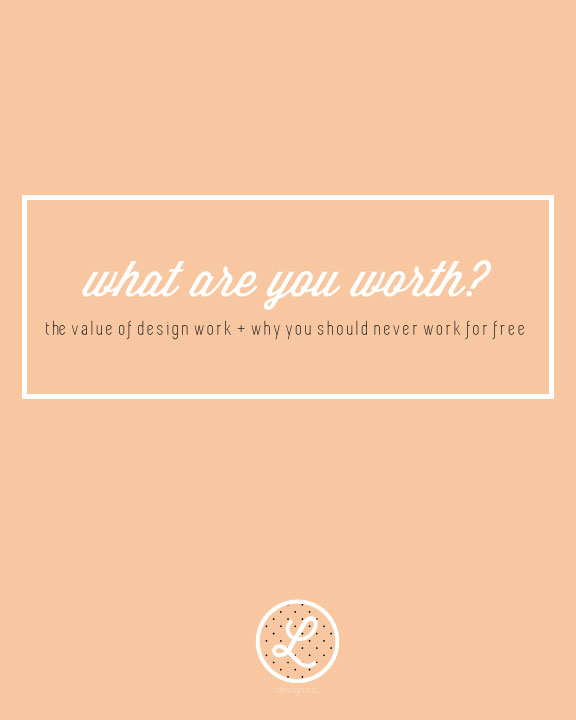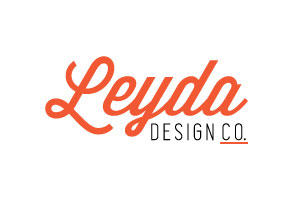What Are You Worth: The Value of Design Work + Why You Should Never Work for Free

I’m so excited to be working on several new projects right now! There is nothing better as a freelancer than being busy because it means your making money. I love design but I also run a business. Freelance isn’t free, ya’ll. Which brings me to a much discussed-and argued about-topic: money. Specifically the value of design and figuring out what to charge your clients.
A week ago I was talking to an acquaintance of mine who dabbles in design. She’s taken some design classes and done some freelance projects. As we talked, the subject of what to charge clients came up. She told me that since she is so “new” to design that she does a lot of free work and when she does charge for work, it’s usually around $50 or less. I’m sure I visibly cringed. I’ve been there. Inexperienced and feeling desperate for work, many designers will work for pennies or nothing at all just to get work. They want to have things to show in their portfolios or see it as playing the long game where they might charge very little now but when the work comes rolling in, they will charge more. I’m here to tell you from experience it’s the worst thing you can possibly do.
Before I started freelance design work, I made and sold jewelry for about 6 years on Etsy and at craft shows. For every person that loved my work and were willing to pay for it, there were others that would make comments about the price and how “they could make that for soooo much cheaper!” There is truth in that. If you only factor in the cost of materials, they could buy those and have a necklace for less than I was charging. But here is the other side of that truth. What I charged was not just for materials cost. I charged for my skill and ideas. I charged for my time, not just in making the item but in marketing my business too. And there was overhead to take into account as well. And packaging. And booth fees and listing fees. You get the idea. Anytime we buy anything we are paying not just for the item itself but for all those other “behind the scenes” things too. The same holds true for design work in terms of pricing and perception.
A lot of businesses understand how important design is to grow their business and will pay for it. Some may understand the value but will try to get the work for insultingly cheap. Those that want it cheap will entice designers through promises of steady work or exposure to get something for free. Stop for a second and think about this scenario: A local business selling small batch coffee opens up. They have great product but they need a designer to create a logo for their company. They call you up and you’re thrilled to get the work. But here’s the catch. They can’t pay you. But once their business becomes super successful just think about all the exposure that logo will get you! You take the job and design a logo. The coffee business does become successful and you proudly put that logo in your portfolio. Hooray, right? No. Branding is the gift that keeps on giving for businesses. We as consumers choose similar items based on branding. If all things are equal, most of us will choose the item that speaks to our values and aesthetics. What you gave that business is something that they will continue to make money on over and over again while you end up with nothing. Sure you have a portfolio piece, but I can assure you that the potential gain you might get from it is nothing compared to what you gave.
Here’s another problem with working for free or too little: you undervalue your work and get labeled as “cheap”. Art and design is a tricky business. It can be difficult for some clients to understand why they need to pay more for quality design when they can get ok work for less. Design isn’t just about the final product you produce. It’s the skills you possess that allows you to create that final product that holds the real value. It transcends the programs you use because those are just tools. The real deal is the aesthetics you posses, the knowledge you have, and the ability to use those tools well. Most businesses that hire designers do so because they don’t have the time or the specific creative know how to do it. They may know what looks good but they don’t know how to achieve it themselves. Or they have no idea what looks good or what would speak clearly to their customers. That’s where you come in! You have something they don’t have and you should be paid for it. You would never go into a business and expect-or demand!-to get something for free. If it’s something you need, you’ll shell out the money for it. Creatives undermine their success when they treat their business like a hobby. Spoiler alert: If you’re a hobbyist you will never ever survive as a freelance designer. You have to value your work in order for people to feel confident in investing in you.
One of the most contested reasons that you shouldn’t work for peanuts is because it has the potential to hit all of us in our pocket books. Design, like art, is one of those skills that people seem to immediately undervalue. I think it’s due to the subjective quality of it or maybe some people are just cheap. I don’t know. But when I see people recommending things like Fivver to businesses for a logo I feel angry and very confused. I’ve heard all the arguments: young/new designers need a way to get work into their portfolio; as long as you’re not being paid that low why do you care?; small businesses need to be frugal. And on and on. Here’s the truth, the market will bare what the market can bare. If businesses see they can get a logo at bargain basement prices, it’s going to effect how they see design in general. How the see design informs what they are willing to pay for it. That has the potential to hurt my bottom line, which in turn makes me cranky. I saw it all the time when selling jewelry. Some crafters would charge $5 for a necklace. They basically sold it for less than material cost. Yes it undervalues their work. And yes there can be assumption that cheap price equals cheaply made. But it also lends credence to the idea that handmade work doesn’t have as much value as what you can buy in a big box store. It ignores all the time, skills, and investment that it takes to do something well. I don’t want to be lumped in with the “fivver” designers of the world. I do quality work, and I want to be paid fairly for it. That’s not ego talking, that’s just common sense. If you want to stay in businesses you need to treat your work like it’s your business because it is.
So what should you charge? Only you can decide. Your price point should take into account several factors such as experience, skill, overhead, your personal marketing costs ect. Some designers charge a flat rate per project and others do an hourly fee. I did an hourly fee but recently changed to a mix of flat rate and hourly depending on the project. Hourly can punish you for efficiency while flat rates can lock you into an endless amount of revisions. I try to make things really clear in my pricing structure, contract, and proposals to avoid both scenarios. This is what works for me but it may not work for you. Finding your price is a process and can sometimes involve some trial and error. Just keep in mind that most designers undercharge vs. overcharge so take that into account.
If you’re still scratching your head about what to charge don’t fret! Read this, this, and this. Those are some really helpful articles that deal with the specifics of pricing your work.






